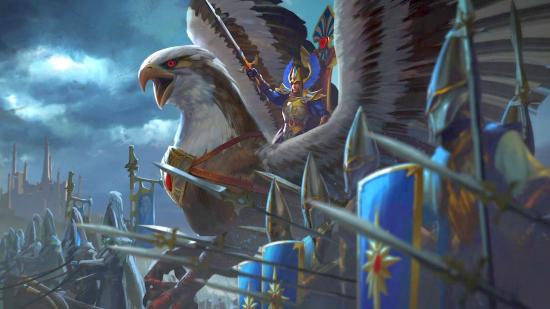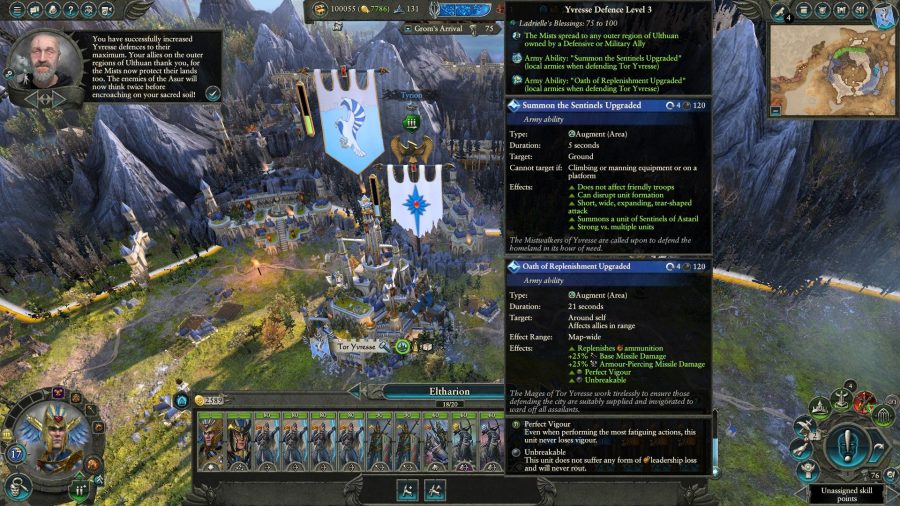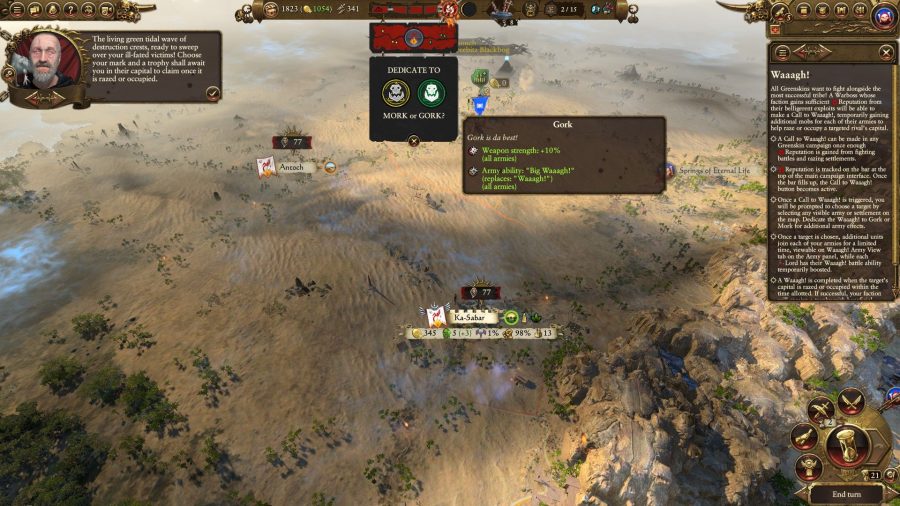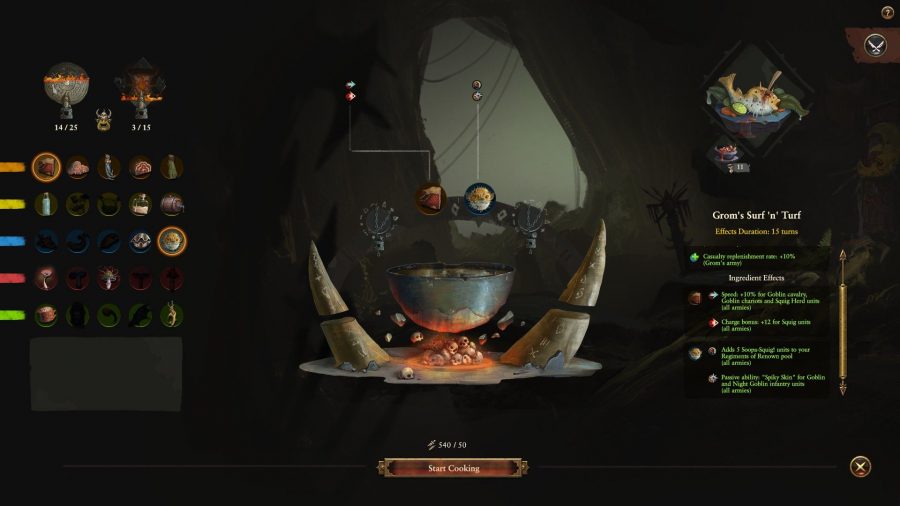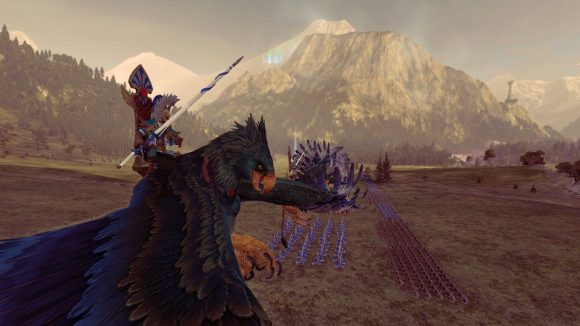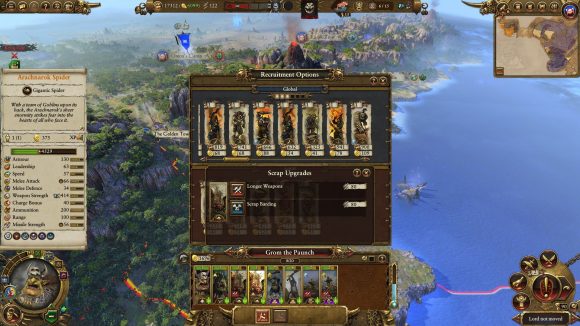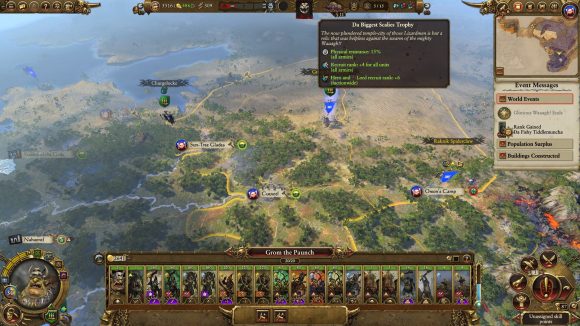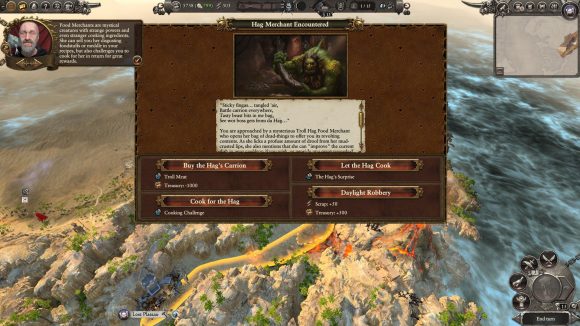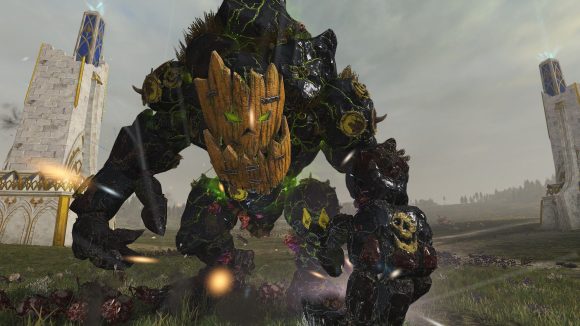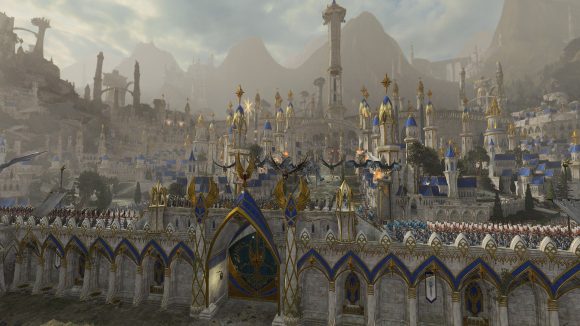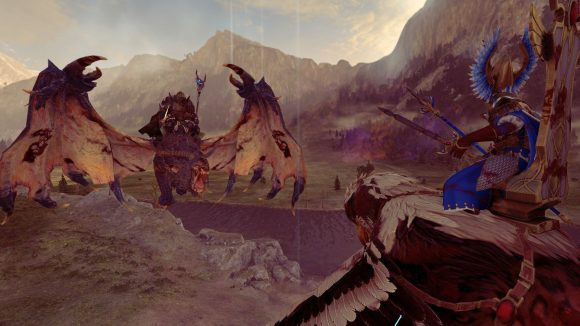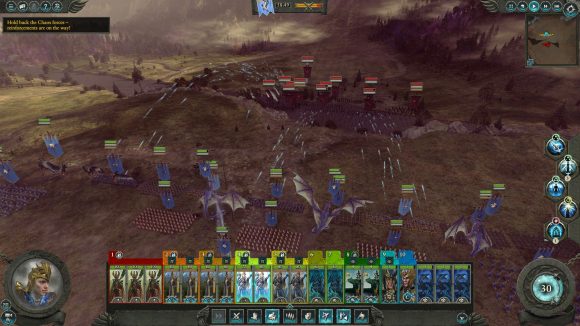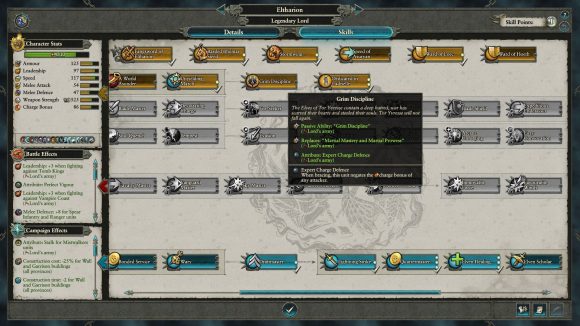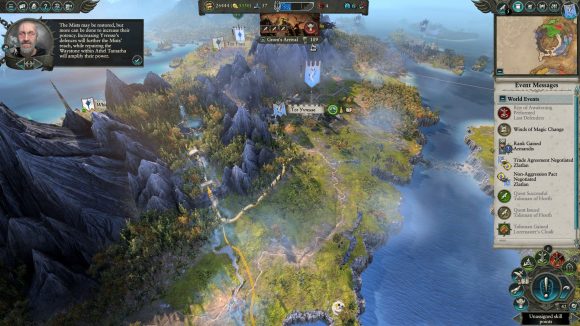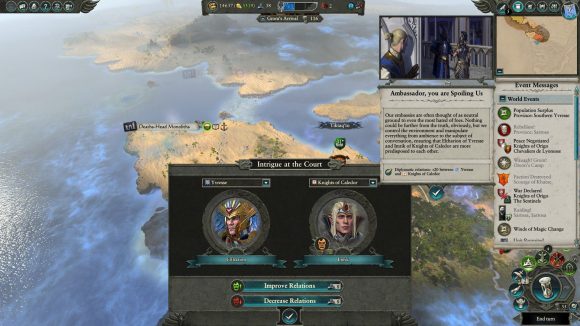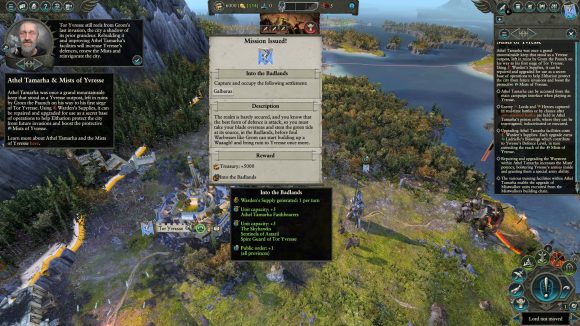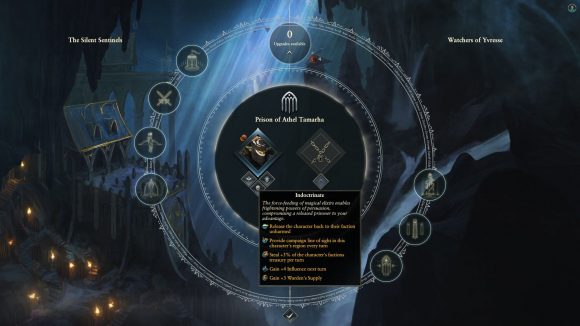Our Verdict
Total War fans after a bold twist on the High Elf or Greenskin campaigns will find this less creative than other Lord packs, but Warhammer fans excited to recreate this storied grudge match will find it no less essential.
The rivalry between Prince Eltharion the Grim, the High Elf Warden of Yvresse, and the Goblin King Grom the Paunch is the most personal of any Total War: Warhammer Lord pack yet – at least, according to the lore. The gluttonous gobbo is the only Greenskin to have successfully invaded the elves’ sacred isle of Ulthuan, with his previous effort defeated by Eltharion at the gates of Tor Yvresse. The two have borne an intense mutual hatred ever since.
It’s not easy telling scripted stories in what is still fundamentally a sandbox game, but Creative Assembly is probably doing the best job of anyone out there. These Lord packs achieve this by offering more structured campaigns than the launch races’ open-ended goal of controlling the Great Vortex, and because neither Eltharion nor Grom play very differently from the core High Elf or Greenskin factions, this structure adds needed replay value, too.
As Eltharion, I start by unifying a chunk of Ulthuan, then proceed to get obscenely rich by using the Intrigue mechanic to make everyone trade with me. This is very like my Tyrion campaign. As Grom, I spend ages stomping around the vastness of the Southlands, just like Grimgor in the Badlands way back in Total War: Warhammer 1. Then a few new wrinkles kick in.
Eltharion has two campaign objectives, one of which is to win the Final Siege of Tor Yvresse – a climactic battle that’s forced upon you after 150 turns, but which you can trigger voluntarily whenever you wish. The second is to get Yvresse’s ‘defence level’ to 100. You’ll do this by upgrading the settlement of Tor Yvresse in the usual manner, but also by upgrading Athel Tamarha, Eltharion’s special underground club for boring elves. It has its own development screen – squint, and you could mistake it for a stripped-down town screen from Heroes of Might and Magic – and its own currency, Warden’s Supply.
The only way to get a trickle of Warden’s Supply per turn, as opposed to in single drops, is completing Eltharion’s pre-emptive missions. Under the narrative guise of hobbling Grom’s second invasion before it starts, these task you with capturing particular settlements in the world – two on the Southlands continent and one in Lustria. Unlike Tyrion or Teclis’s campaigns, where you can get ritual currency from any of dozens of sites, they push you to very particular places.

Eltharion has a couple of other cool tricks that are pleasingly thematic for Warhammer nerds. Raising Yvresse’s defence level reactivates the Mists of Yvresse, and then spreads them to any owned or allied territory on the outer ring of Ulthuan. They inflict attrition damage on all enemies and grant various buffs to allies, representing the magical defences of the High Elves’ homeland that have always existed in the lore – it’s cool to imagine a tribe of pillaging goblins getting lost in the mist or picked off by keen-eyed, solemn elven sentinels, which is the fate that is supposed to await an invader of Ulthuan, yet until now the island has been as inviting a target as anywhere else.
Those elven sentinels are represented as a brand new line of ‘Mistwalker’ units exclusive to Eltharion. These are the highlight of his campaign, and none more so than the Knights of Tor Gaval – griffin-riding monstrous cavalry even more potent than Bretonnia’s Royal Hippogryph Knights (they’re 2600 gold apiece in custom battle – 200 more than a Star Dragon). As is tradition, this DLC also adds a few units from both its factions’ tabletop rosters: High Elves get Archmage heroes with access to High Magic as well as all eight Wind lores, War Lions of Chrace, and Lion Chariots (still no Lothern Skycutter, though), while Greenskins get Snotling Pump Wagons and some more trolls. Arcane Phoenixes and Rogue Idols are also added, plucked from more obscure rulebooks.
While Eltharion’s fathomless wealth saw me cruise to an easy win, Grom’s campaign is the one to pick if you want a challenge. Starting in the Southern World’s Edge Mountains, he’s surrounded by enemies – Kroq-Gar to the south, Settra to the north, and an unusually united Ulthuan across the sea. Eltharion was distressingly successful at bribing his kin to join his little vendetta, such that I was struggling to finish off Kroq-Gar while also defending my northern coast against waves of elves – with multiple stacks often coming within ten turns of the last having been repelled. The script of Grom invading Ulthuan was very much flipped; I’ve never seen so many factions travel such a distance to pursue a war in this game, and it was an enjoyable, if exhausting and occasionally infuriating, strategic challenge.
The long-awaited Greenskin rework was very helpful here. Winning battles now adds to your ‘reputation’ just as it used to build ‘fightiness’, but most of the downsides are gone. Low reputation incurs penalties to obedience, growth, and leadership, but is very easy to avoid, and won’t cause attrition losses to your armies. This meant I could leave some Lords sitting idle on my northern coast, watching for the pointy-eared invaders.
Calling a Waaagh! is far more helpful now, too. Rather than spawn a single, AI-controlled army, each of your armies gets a second tab where Waaagh! units will appear – effectively, you can run 40-stacks now. Waaagh! armies are typically weaker than their parents, and take several turns to gather, but there’s no pesky coordination with the AI any more, nor any risk of it doing something stupid to piss off a neighbour (prematurely, I mean). Better yet, upon gathering enough reputation you can call a Waaagh! whenever you choose – I didn’t feel the need while mopping up the Tomb Kings, but when Kroq-Gar came after me, the reinforcements were a life-saver. This makes the whole mechanic a far more tactical choice.
Greenskins also get a new currency: scrap, representing battlefield loot gathered and jerry-rigged in the Goblins’ haphazard way. It’s required for certain techs, but its main purpose is to upgrade your troops. These upgrades are applied to individual units, which can be a bit of a hassle, but the buffs are huge: +25% weapon strength for Orc Boys or +10 attack vs infantry for chariots, to name just two. The upgrades are more expensive for stronger units, but scrap is pretty plentiful, and unless you’re in the habit of getting your units killed all the time it won’t be hard to maintain multiple armies of fully kitted out troops.
Grom’s unique mechanic is his gluttony. He gets a cauldron in which to cook a number of disgusting Greenskin delicacies with ingredients that you’ll gradually unlock as you play, from quests, major battles, and a Food Merchant who will periodically appear on the map. Again, each meal confers some substantial buffs on both Grom and on your faction: Shroom ‘n’ Offal Sausage, for instance, grants the ‘Bangers and Smash’ battle ability and +25 charge bonus for Grom, while goblins in all armies get Regeneration, and all provinces get +10 Growth.
This may be the first campaign mechanic of any Lord pack that’s fun to fiddle with in itself rather than valuable for its gameplay benefits (though it is that, too). I mixed ingredients according to what actually sounded nice, like Stunty Ale with Boar Meat (result: The Magnum Pizza). There are 15 different recipes to cook in total, of which you must cook at least 12 to unlock the option to challenge Eltharion and trigger the final battle – hence, eating gross meals is Grom’s campaign objective.
Since you can preview every meal before you commit to cooking it, it’s easy enough to ensure each meal you do cook is new. The hard limit on hitting the magic 12, then, is in discovering the ingredients, but there’s a softer brake too: every meal lasts 15 turns before its buffs expire, and I was often hesitant to chuck one out if said buffs were particularly useful to my current situation. Gating campaign progression behind the cauldron can therefore interfere with its usefulness as a strategic tool.
Where The Hunter and The Beast and The Prophet and The Warlock both struck a nice balance between adding more toys and deeply differentiated campaigns, The Warden and The Paunch is much more of the former. Thus it’s not quite as refreshing to play, but I understand why: Creative Assembly has always been guided by the lore, which gives no real reason for either Eltharion or Grom to differ as much from their core races as Nakai, Wulfhart, or Tehenhauin do. Eltharion’s Mistwalkers and Grom’s Cauldron are still fun to play with, and as Grom is the first Greenskin to be playable in the Vortex campaign, fans may appreciate being able to taste the vanilla experience there.
More like this: Check out the best strategy games on PC
Ever since Creative Assembly dredged up the likes of the Fimir and the Necrofex Colossus, it’s been clear that the Total War studio is determined to realise the Warhammer world with a fidelity that no one expected when the series was first announced. Given this, having Eltharion the Grim face off against Grom the Paunch simply had to be done at some point, and even if this Lord pack doesn’t quite match the inventiveness of others, Total War: Warhammer’s extraordinary post-launch support is the standout example of a whole that is greater than the sum of its parts. Seeing Grom and Eltharion line up alongside every other icon of the Warhammer world when I start a Mortal Empires campaign can’t help but raise a smile.
